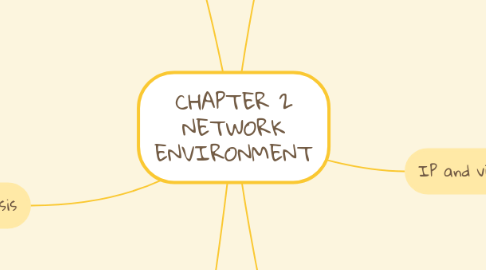
1. gateways
1.1. joins two networks so the devices on one network can communicate with the devices on another network.
1.2. categories
1.2.1. Unidirectional gateways
1.2.2. Bidirectional gateways
2. protocol analysis
2.1. TCP/IP suite protocol
2.2. TCP interfaces
2.3. problem related to TCP
2.3.1. Packet replication
2.3.2. Checksum error
2.3.3. Bottleneck bandwidth
2.3.4. Packet loss
2.4. IP Datagram
2.4.1. Maximum Transfer Unit (MTU)
2.4.2. Fragmentation
2.4.3. Encapsulation
2.5. modes in Encapsulating Security Payload (ESP)
2.5.1. Tunnel mode
2.5.2. Transport mode ESP
2.6. IPv6 header format.
2.7. common protocols and standards
2.7.1. Domain Name Server Security (DNSSEC)
2.7.2. Generic Security Services API (GSSAPI)
2.7.3. Secure Sockets Layer (SSL)
2.7.4. Secure Hypertext Transfer Protocol (SHTTP)
2.7.5. Security Tokens
2.7.6. BlackDuck
2.7.7. OpenLogic
3. ghngmgmj,jh,j
3.1. n vnz bvdxz
4. key elements in a network
4.1. Nodes
4.1.1. can be a computer, printer, or any other device capable of sending and/or receiving data generated by other nodes on the network.
4.2. Network Backbone
4.2.1. part of computer network that interconnects various pieces of network, providing a path for the exchange of information between different LANs or subnetworks.
4.3. Segments
4.3.1. segment is a small section of a network
4.4. Subnets
4.4.1. subnetwork or subnet, is a logically visible subdivision of an IP network.
5. IP and virtual addresses
5.1. Internet Protocol Address
5.1.1. An Internet Protocol address (IP address) is a numerical label assigned to each device (e.g., computer, printer) participating in a computer network that uses the Internet Protocol for communication.
5.1.2. IPv4
5.1.2.1. Internet Protocol version 4
5.1.2.2. consists of 32 bits
5.1.3. IPv6
5.1.3.1. A new Internet addressing system Internet Protocol version 6 (IPv6) is being deployed to fulfill the need for more Internet addresses
5.1.3.2. consists of 128 bits
5.1.3.3. allow for approximately three hundred and forty trillion, trillion unique IP addresses
5.2. Virtual IP address
5.2.1. an IP address that is shared among multiple domain names or multiple servers.
5.2.2. A virtual IP address eliminates a host's dependency upon individual network interfaces.
5.2.3. Incoming packets are sent to the system's VIPA address, but all packets travel through the real network interfaces.
